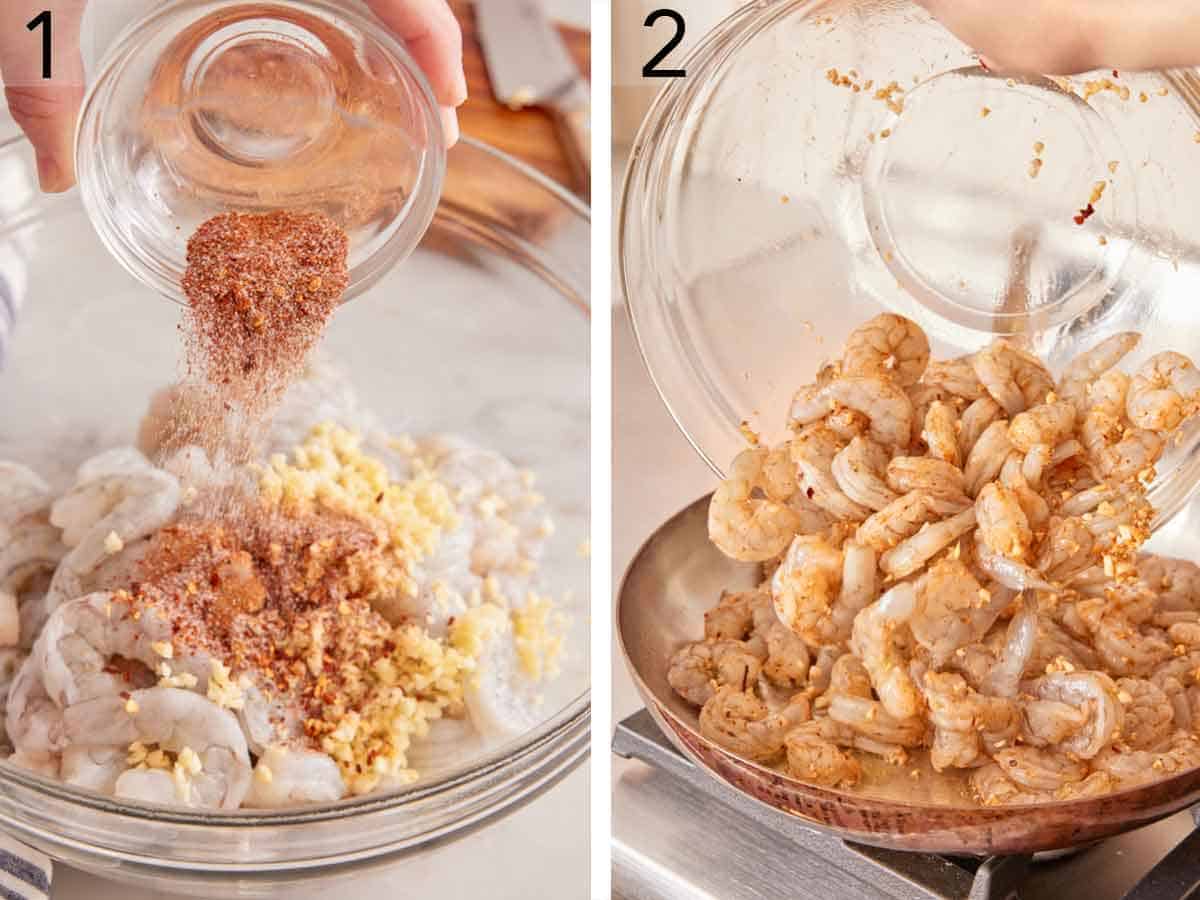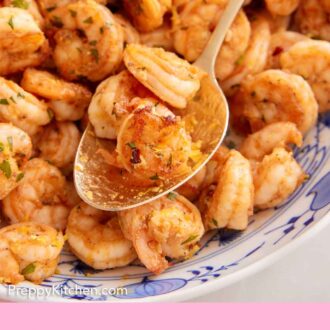Don’t let this simple sautéed shrimp recipe fool you! It may seem simple with its short ingredient list, but this sautéed shrimp dish is juicy and full of flavor. It is perfect for any occasion, from entertaining guests to a quick weeknight dinner. The shrimp only takes a few minutes to cook, and it goes with everything, making it the perfect addition to any meal.
It may seem difficult to cook the perfect sautéed shrimp, but this post will guide you to getting perfectly plump and tender shrimp every single time. You’ll be whipping up shrimp for dinner every night like a pro!
I you want another shrimp recipe, then try my garlic shrimp recipe, bacon wrapped shrimp recipe, shrimp ceviche recipe, or shrimp scampi recipe. There are so many easy ways to incorporate shrimp into your meals!
What You Need to Make This Recipe

Seasoning — you can use any combination of seasoning you’d like! I use garlic, salt, paprika, pepper, and red pepper flakes to create a delicious savory flavor that goes with the shrimp’s mild sweetness.
Shrimp — shrimp comes in a variety of sizes. The bags of shrimp will have a number on them to let you know the size. Generally, the larger the number on the bag, the smaller the shrimp in the bag! Large shrimp (31/35 per pound) is ideal as small shrimp will cook too quickly, and they’re easy to overcook. Make sure to clean and devein shrimp before cooking or buy pre-peeled and deveined to reduce the preparation time. You can use shrimp with tails on or off. If you are buying fresh shrimp, make sure they do not have any odor and are sold over a large bed of ice.
Oil — you can use your favorite neutral oil to sauté the shrimp in. I’m using olive oil.
Lemon — lemon juice and zest adds a light, bright flavor to the shrimp. Use freshly squeezed lemon juice instead of bottled lemon juice, as the flavor is better.
How to Make Sautéed Shrimp

1. Combine the shrimp, garlic, salt, paprika, pepper, and red pepper flakes in a medium mixing bowl. Toss together until the shrimp is well-coated.
2. Heat the oil in a large skillet over medium-high heat. Add the shrimp and cook, stirring occasionally, until the shrimp are pink and opaque.

3. Remove from the heat and stir in the lemon juice.
4. Top the sautéed shrimp with the lemon zest. Garnish with parsley.

Pro Tips for Making This Recipe
- Shrimp cooks very quickly, so keep a close eye on them in the skillet. Once the shrimp turns opaque, it’s time to remove the shrimp from the heat.
- Always pat shrimp dry with a paper towel, especially if you are thawing it from frozen. Patting the shrimp will remove excess moisture to give your shrimp the best possible texture and help the seasoning stick better. If there is moisture, the shrimp will steam instead of sear in the skillet.
- The larger the skillet, the better! The shrimp should be in a single layer in the skillet. If you use a small skillet, the shrimp will overlap and steam.
- When zesting a lemon, stop zesting once you reach the white layer, as the white is bitter.
- Remove the sautéed shrimp from the pan once you’ve added the lemon and parsley so it doesn’t continue cooking from the pan’s residual heat.

Frequently Asked Questions
You sure can! If you live in an area where fresh shrimp is not easily accessible, then frozen shrimp is a great option. Frozen shrimp tend to be frozen shortly after being caught, so they are often high quality while being much more budget-friendly.
Check the bag your frozen shrimp comes in for the ideal instructions. You can thaw shrimp overnight in the fridge, but some bags recommend you thaw it in water. To thaw frozen shrimp in water, place the shrimp in a colander and run them under cold water. Make sure you pat the shrimp dry to get a nice sear on the shrimp.
Start by peeling the shrimp if they are not already peeled. Use a small paring knife to cut along the outer edge of the shrimp’s back, around ¼-inch deep. Then, use the tip of the knife to dig and pull out the dark vein. Repeat with the rest of the shrimp.
This sautéed shrimp recipe tastes best when enjoyed immediately. However, you can store leftover shrimp in the fridge for up to 3 days in an airtight container. You can reheat them quickly on the stovetop.
If you’ve tried this Sautéed Shrimp recipe, then don’t forget to rate the recipe and let me know how you got on in the comments below, I love hearing from you!

Sautéed Shrimp
Video
Equipment
- Large skillet
- mixing bowl
Ingredients
- 1½ pounds large shrimp peeled and deveined, tails on or off (675g)
- 5 garlic cloves minced
- ¾ teaspoon salt
- ¾ teaspoon paprika
- ½ teaspoon ground black pepper
- ¼ teaspoon red pepper flakes optional
- 2 tablespoons olive oil
- 1 lemon zested and juiced
- 1 tablespoon chopped parsley for garnish
Instructions
- Thaw the shrimp, if using frozen. Pat shrimp dry with paper towels.
- In a medium mixing bowl, combine the shrimp, garlic, salt, paprika, pepper, and red pepper flakes. Toss together until the shrimp is well coated.
- Heat the oil in a large skillet over medium-high heat. Add the shrimp and cook, stirring occasionally, until the shrimp are pink and opaque, about 3 minute. Remove from the heat and stir in lemon zest and juice. Garnish with parsley.
Notes
- Shrimp cooks very quickly, so keep a close eye on them in the skillet. Once the shrimp turns opaque, it’s time to remove the shrimp from the heat.
- Always pat shrimp dry with a paper towel, especially if you are thawing it from frozen. Patting the shrimp will remove excess moisture to give your shrimp the best possible texture and help the seasoning stick better. If there is moisture, the shrimp will steam instead of sear in the skillet.
- The larger the skillet, the better! The shrimp should be in a single layer in the skillet. If you use a small skillet, the shrimp will overlap and steam.
- When zesting a lemon, stop zesting once you reach the white layer, as it’s bitter.
- Remove the shrimp from the pan once you’ve added the lemon and parsley so it doesn’t continue cooking from the pan’s residual heat.















rita says
Made this recipe and I love the stuffed squash blossoms! So refreshing and beautiful!!!
jkanell says
So happy you liked it!